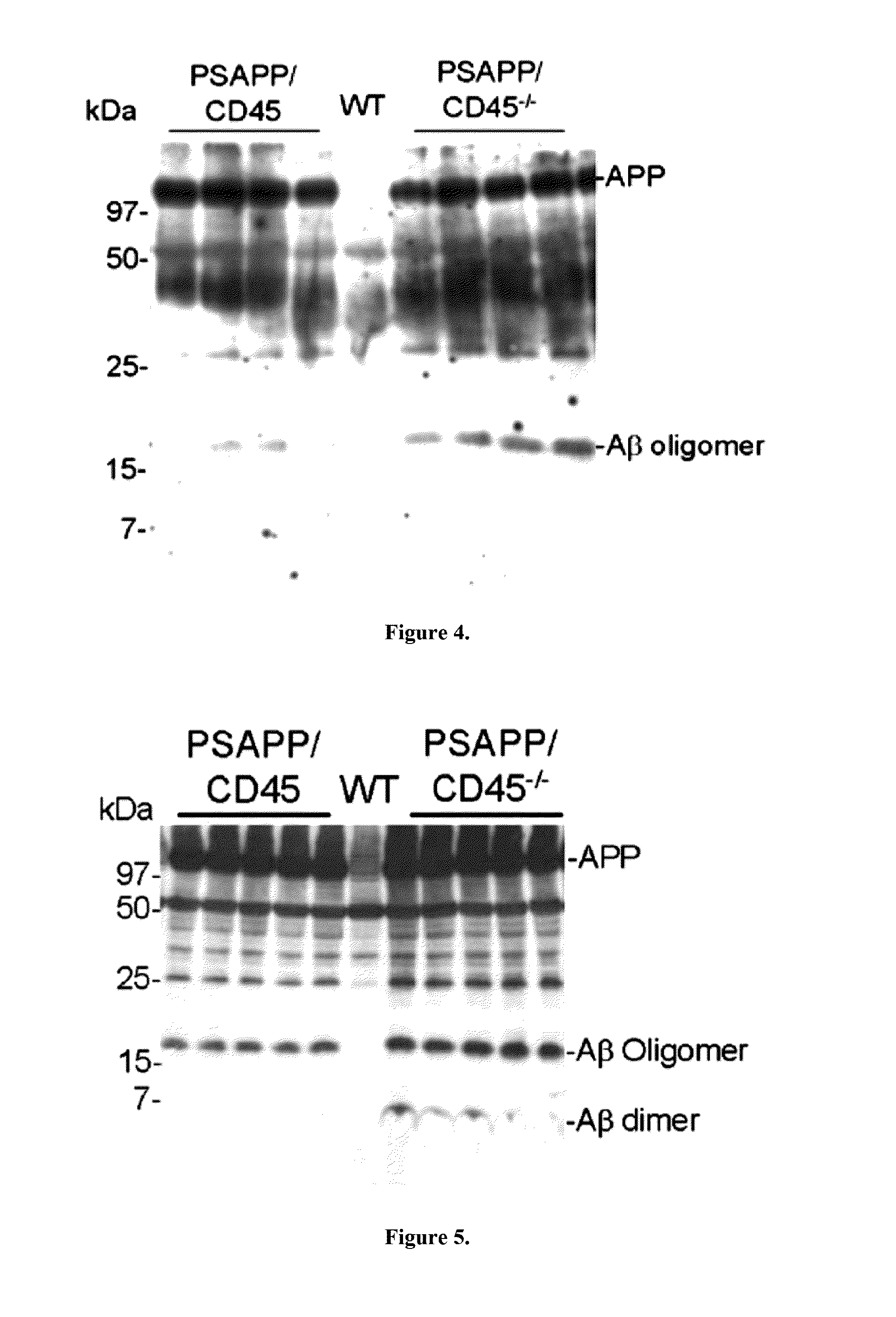Transgenic model of alzheimer's disease
a transgenic model and alzheimer's disease technology, applied in the field of alzheimer's disease models, can solve the problems of toxic accumulation of a species, achieve the effects of reducing the number of patients
- Summary
- Abstract
- Description
- Claims
- Application Information
AI Technical Summary
Benefits of technology
Problems solved by technology
Method used
Image
Examples
example 1
[0051]The cerebral amyloidosis of aged PSAPP mice deficient in CD45 was examined. Brain Aβ deposition is a pathognomonic feature of AD (Selkoe, (2001) Alzheimer's disease: genes, proteins, and therapy. Physiol Rev 81:741-766), and oligomeric Aβ species are thought to be a driving force in AD-type neurodegeneration (Klyubin, et al., (2005) Amyloid beta protein immunotherapy neutralizes Abeta oligomers that disrupt synaptic plasticity in vivo. Nat Med 11:556-561; Walsh., et al., (2005) The role of cell-derived oligomers of Abeta in Alzheimer's disease and avenues for therapeutic intervention. Biochem Soc Trans. 33:1087-1.090; Shankar, et at, (2008) Amyloid-beta protein dimers isolated directly from Alzheimer's brains impair synaptic plasticity and memory. Nat Med 14:837- 842), The double-transgenic PSAPP mouse (Jankowsky, et at, (2001) Co-expression, of multiple transgenes in mouse CNS: a comparison of strategies. Biomol Eng 17:157-165) is a widely used model of cerebral amyloidosis, ...
example 2
[0058]The brain-to-blood Aβ clearance capacity of aged PSAPP / CD45− / − mice was examined. It has been proposed that cerebral Aβ is cleared across the blood-brain barrier (BBB) via a “peripheral sink,” and there is evidence of dysfunctional brain-to-blood Aβ clearance in AD patients and in transgenic mouse models of the disease (DeMattos, et al., (2001) Peripheral anti-A beta antibody alters CNS and plasma A beta clearance and decreases brain A beta burden in a mouse model of Alzheimer's disease. Proc Natl Acad Sci U S A 98:8850-8855; Deane, et al, (2003) RAGE mediates amyloid-beta peptide transport across the blood-brain barrier and accumulation in brain. Nat Med 9:907-913), To determine whether CD45 deficiency impacted relative Aβ abundance in cerebral and systemic compartments, brains and plasma from CD45-deficient and -sufficient PSAPP mice were probed using a biochemical approach. The total insoluble Aβ species (including Aβ1-40 and Aβ1-42) in PSAPP / CD45− / − and PSAPP / CD45 mouse br...
example 3
[0061]CD45 deficiency was analyzed to determine the inflammatory effect on microglia in PSAPP mice. Microglia are activated in close vicinity of β-amyloid plaques in AD patient brains and in transgenic mouse models of the disease (Benzing, et al., (1999) Evidence for glial-mediated inflammation in aged APP(SW) transgenic mice. Neurobiol Aging 20:581-589; Jimenez, et al., (2008) Inflammatory response in the hippocampus of PSIM146L / APP751SL mouse model of Alzheimer's disease: age-dependent switch in the microglial phenotype from alternative to classic. J Neurosci 28:11650-11661; Mandrekar-Colucci and Landreth, (2010) Microglia and inflammation in Alzheimer's disease. CNS Neurol Disord Drug Targets 9:156-167). Although it was once thought that microglial “activation” was a single phenotype, it is now known that multiple forms of functionally distinct reactive microglia, exist (Town, et al., (2005) The microglial “activation” continuum: from innate to adaptive responses. J Neuroinflamma...
PUM
| Property | Measurement | Unit |
|---|---|---|
| Solubility (mass) | aaaaa | aaaaa |
Abstract
Description
Claims
Application Information
 Login to View More
Login to View More - R&D
- Intellectual Property
- Life Sciences
- Materials
- Tech Scout
- Unparalleled Data Quality
- Higher Quality Content
- 60% Fewer Hallucinations
Browse by: Latest US Patents, China's latest patents, Technical Efficacy Thesaurus, Application Domain, Technology Topic, Popular Technical Reports.
© 2025 PatSnap. All rights reserved.Legal|Privacy policy|Modern Slavery Act Transparency Statement|Sitemap|About US| Contact US: help@patsnap.com



